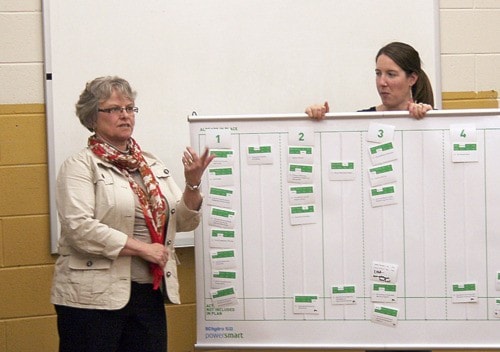A recent workshop held in Barriere was about “business as usual” in the communities of Barriere and Clearwater, and what this would mean for future greenhouse gas emissions, and how these could be reduced over the next several years by setting achievable targets. The workshop was part of the BC Hydro Community Energy and Emissions Planning: QuickStart Program, with facilitators Community Energy Planners (CEA) Megan Lohmann, and Peter Robinson.
Participants attended from the District of Barriere and Clearwater including mayors, council members and key stakeholders.
April Shaw, called in to the workshop from BC Hydro to explain a number of interesting opportunities that BC Hydro has available to support actions in provincial communities. She advised that T12 tube lighting will soon no longer be available, and therefore advised small business owners currently using this lighting to consider changing their lights, noting BC Hydro currently has a $10,000 cost incentive on a lighting retro-fit. Shaw went on to add that BC Hydro also has a Powersmart Program for large businesses who spend over $200,000 annually on electricity. As well there is a new construction program which includes a lighting defined program that includes cash incentives for the builder. There is also a new home energy star program package with an $800 rebate incentive for energy star appliances.
Most importantly though she explained BC Hydro offers a program for those on low incomes that provides retro fitting opportunities. The program requires a free assessment done by an approved contractor for those who qualify within the income bracket. The assessment looks at; insulation in attics, draft proofing windows and doors, water conservation, domestic hot water, and shower heads. If any of these items need upgrades or repair she stated that BC Hydro will have someone come in and do the work. BC Hydro will also supply an energy efficient fridge at no cost if the qualifying homeowner’s current one does not meet energy use standards. More information on a number of other programs that include a $30 fridge buy back program, car upgrade incentives, and much more can be found at: www.bchydro.com/powersmart
Lohmann said the day’s workshop was based on policies and actions already started in each respective community, saying by working together there will be a “focusing on cross-pollination of community ideas from both towns”.
She noted community planning is required to address our fears about climate change and available energy in the future, with such planning bringing “hope for the future.”
“Both communities have done a good job with their OCP’s (Official Community Plan) and addressing emissions aggressively,” said Lohmann, “The future will be quite different from the past, and planning for the future will allow us to prepare for what future scenarios may be.”
She asked, “What if climate change is a hoax?” and then pointed out that if planning for a future with climate change, should that change not take place, the results of this kind of future planning will still be a benefit for the world. “This kind of planning will have created energy efficiency, green jobs, clean air, healthier living, and healthy children.”
Lohmann noted the four ‘R’s’ of importance regarding energy planning for the future: 1) reduce energy demand, 2) re-use waste heat. 3) renewable heat sources, and 4) renewable energy for electricity.
This kind of planning also involves answering questions such as, “Where to start with buildings?” and “Where to start with transportation?”
Lohmann said the model used for the workshop would use the following stats for each community based on their individual OCP’s: Barriere with a 10 per cent greenhouse gas reduction by 2020, and a 33 per cent reduction by 2050; Clearwater with 33 per cent by 2020, and 80 per cent by 2050.
Participants in the workshop then considered the planning actions defined for their community related to energy conservation and green house gas emissions; defining those already accomplished or implemented, those being worked on, those to be considered, and actions that were deemed to be not a consideration for the community.
The results of these findings were then taken by the two CEA planners during lunch break and input into their computers, so the results could be seen on a graph showing the implications of those actions as discussed, and how they might bring the community closer to its OCP on greenhouse gas emissions into future years.
The graphs created for Barriere showed promise, with targets being met by 2019. The graph showed the most impacting items for improvement to be made showed land use and waste.
The CEA’s noted Clearwater’s OCP had some “pretty high targets”, and therefore they were further away from the project target dates on the graph. Lomann said, “To meet your [OCP] targets it will take some pretty aggressive actions by Clearwater community members to meet these targets down the road. Using a little less aggressive plan now will meet your target by 2020.”
Robinson stated, “The greater the population increases, the harder it is to meet the target.”
The balance of the workshop was spent discussing and calculating costs regarding impacts to the communities for items such as organic waste reduction, septage, composting, and recycling to reduce tipping fees. District of Barriere representatives noted the community was the largest recycler of cardboard in the Thompson Nicola Regional District (TNRD), and that Barriere was the first community within the TNRD to have blue bag curbside pickup.
Participants said they all agreed an immediate action both communities could take would be to aggressively educate their residents about the four ‘R’s’ and to encourage their implementation on an individual household basis.
